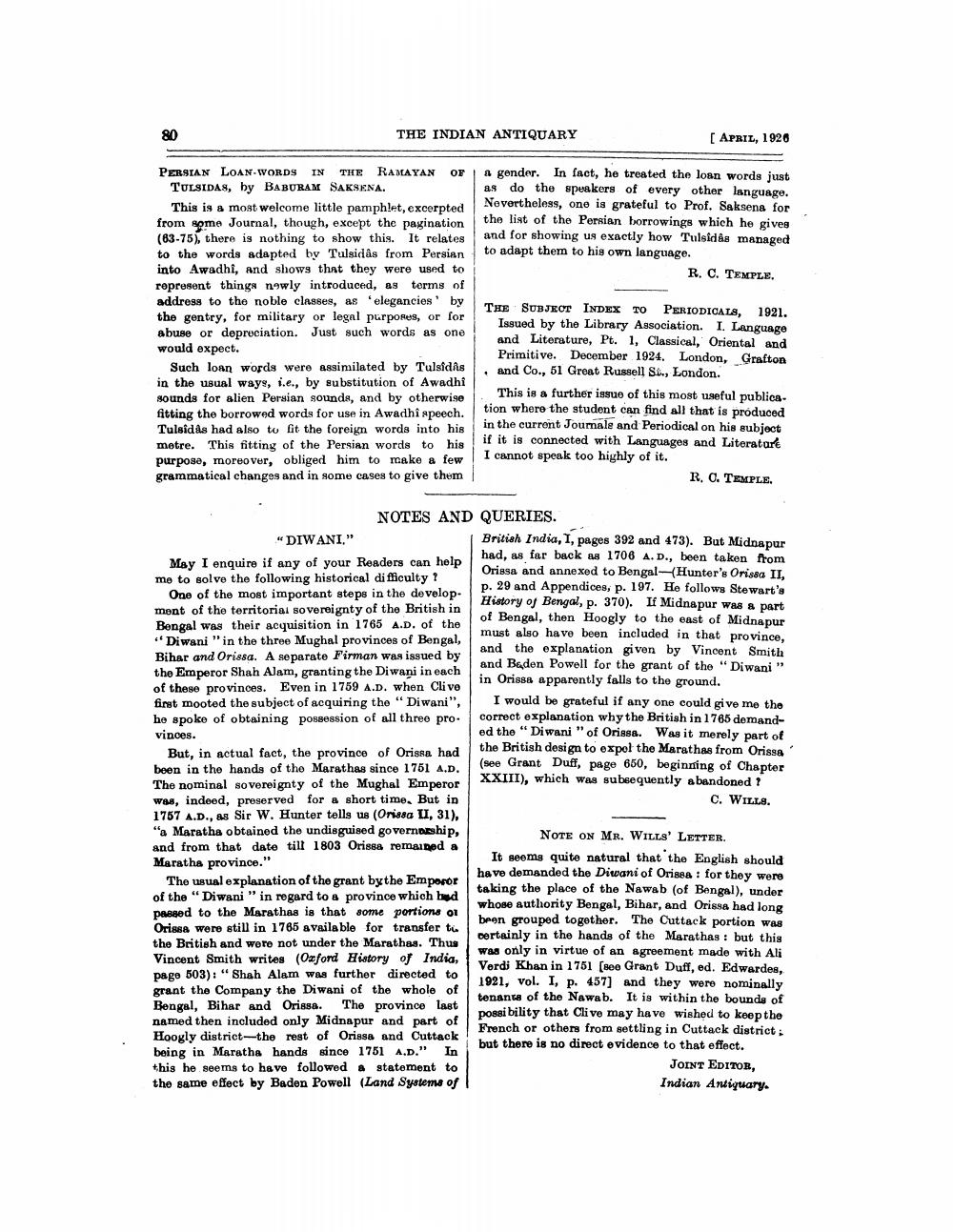________________
THE INDIAN ANTIQUARY
[ APRIL, 1926
A gender. In fact, he treated the loan words just as do the speakers of every other language. Nevertheless, one is grateful to Prof. Saksena for the list of the Persian borrowings which he gives and for showing us exactly how Tulsidas managed to adapt them to his own language.
R. C. TEMPLE.
PERSIAN LOAN.WORDS IN THE RAMAYAN OF
TULSIDAS, hy BABURAM SAKSENA.
This is a most welcome little pamphlet, excerpted from some Journal, though, except the pagination (83-75), there is nothing to show this. It relates to the words adapted by Tulsidås from Persian
v Tulsidas from Persian into Awadhi, and shows that they were used to represent things newly introduced, as terms of address to the noble classes, as elegancies by the gentry, for military or legal purposes, or for abuse or depreciation. Just such words as one would expect.
Such loan words were assimilated by Tulsidas in the usual ways, i.e., by substitution of Awadhi sounds for alien Persian sounds, and by otherwise fitting the borrowed words for use in Awadhi speech.
Tulsidas had also to fit the foreign words into his metre. This fitting of the Persian words to his purpose, moreover, obliged him to make a few grammatical changes and in some cases to give them
THE SUBJECT INDEX TO PERIODICALS, 1921.
Issued by the Library Association. I. Language and Literature, Pt. 1, Classical, Oriental and Primitive. December 1924. London, Grafton and Co., 51 Great Russell St., London.
This is a further issue of this most useful publication where the student can find all that is produced in the current Joumale and Periodical on his subject if it is connected with Languages and Literature I cannot speak too highly of it.
R. O. TEMPLE.
NOTES AND QUERIES. " DIWANI."
British India, 1, pages 392 and 473). But Midnapur
had, as far back as 1706 A.D., been taken from May I enquire if any of your Readers can help
Orissa and annexed to Bengal-Hunter's Orissa II, me to solve the following historical difficulty ?
p. 29 and Appendices, p. 197. He follows Stewart's One of the most important steps in the develop.
History of Bengal, p. 370). If Midnapur was a part ment of the territorial sovereignty of the British in
of Bengal, then Hoogly to the east of Midnapur Bengal was their acquisition in 1765 A.D. of the
must also have been included in that province, "Diwani "in the three Mughal provinces of Bengal,
and the explanation given by Vincent Smith Bihar and Orissa. A separate Firman was issued by
and Baden Powell for the grant of the "Diwani" the Emperor Shah Alam, granting the Diwani in each
in Orissa apparently falls to the ground. of these provinces. Even in 1759 A.D. when Clive first mooted the subject of acquiring the “Diwani", I would be grateful if any one could give me the he spoke of obtaining possession of all three pro. correct explanation why the British in 1765 demandvinces.
ed the "Diwani " of Orissa. Was it merely part of But, in actual fact, the province of Orissa had
the British design to expol the Marathas from Orissa
(see Grant Duff, page 650, beginning of Chapter been in the hands of the Marathas since 1761 A.D.
XXIII), which was subsequently abandoned ? The nominal sovereignty of the Mughal Emperor was, indeed, preserved for a short time. But in
C. WILLS. 1757 A.D., as Sir W. Hunter tells us (Orissa UI, 31), "a Maratha obtained the undisguised governdeship,
NOTE ON MR. WILLS' LETTER. and from that date till 1803 Orissa remained a
It seemg quite natural that the English should Maratha province."
have demanded the Diwani of Orissa : for they were The usual explanation of the grant by the Emperor
taking the place of the Nawab (of Bengal), under of the “Diwani " in regard to a province which had
whose authority Bengal, Bihar, and Orissa had long passed to the Marathas is that some portions on
been grouped together. The Cuttack portion was Orissa were still in 1765 available for transfer tu
certainly in the hands of the Marathas : but this the British and were not under the Marathas. Thus
was only in virtue of an agreement made with Ali Vincent Smith writes (Oxford History of India,
Verdi Khan in 1751 (see Grant Duff, ed. Edwardes, page 503): "Shah Alam was further directed to
1921, vol. I, p. 457] and they were nominally grant the Company the Diwani of the whole of
tenants of the Nawab. It is within the bounds of Bengal, Bihar and Orissa. The province last
possibility that Clive may have wished to keep the named then included only Midnapur and part of
French or others from settling in Cuttack district : Hoogly district-the rest of Orissa and Cuttack being in Maratha hands since 1751 A.D." In
but there is no direct evidence to that effect. this he seems to have followed a statement to
JOINT EDITOR, the same effect by Baden Powell (Land Systems of
Indian Antiquary.




